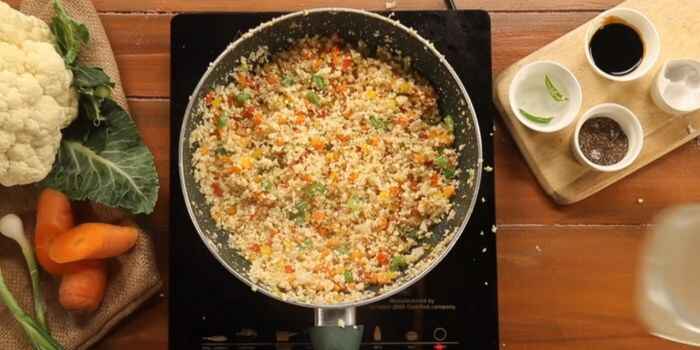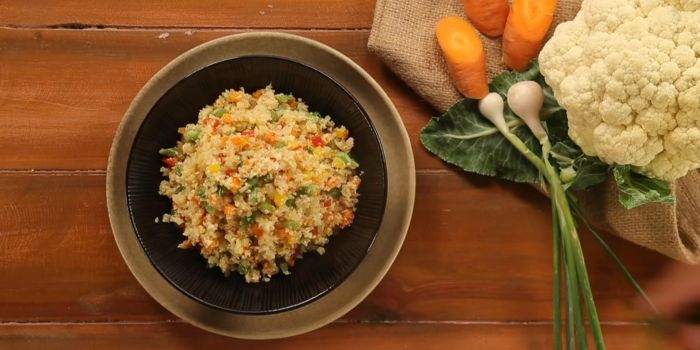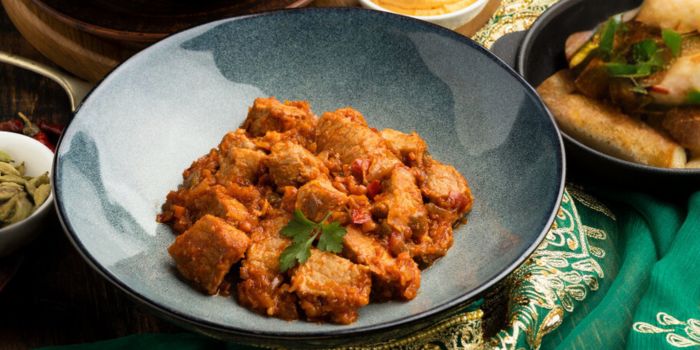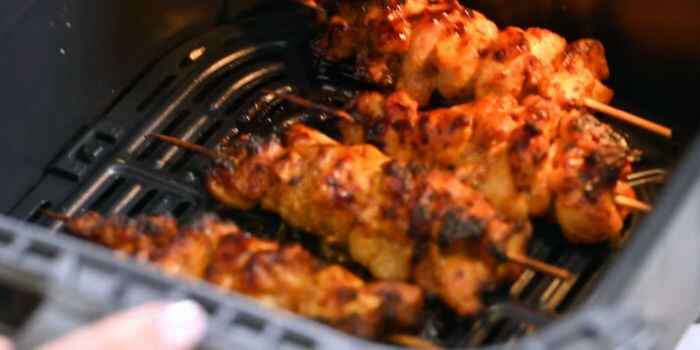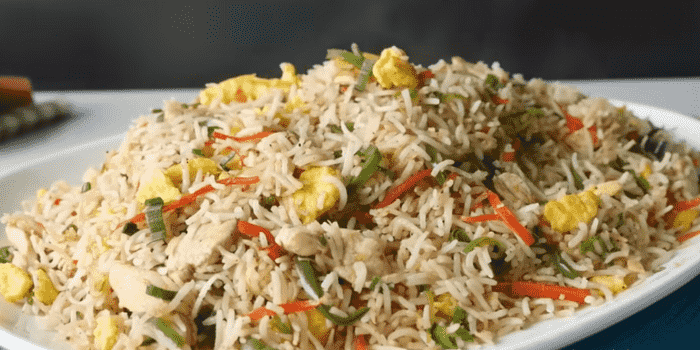Cauliflower rice is a simple and low-carb alternative to traditional rice, perfect for anyone looking to add more vegetables to their diet. This recipe involves grating or processing cauliflower into riced pieces that resemble granules of rice. Cooking it from scratch is incredibly easy. You can either sauté it in a skillet or roast it in the oven. This versatile vegetable can be used in a variety of dishes, from bowls and arancini to stir fries and meal prep.
Light & Flavorful Cauliflower Rice
Start by grating or chopping 1/4 medium cauliflower head into rice-sized pieces. Heat 1 tablespoon of olive oil in a skillet over medium heat. Add finely chopped onion and minced garlic, cooking until fragrant. Mix in diced carrots and peas, then stir in the cauliflower rice.
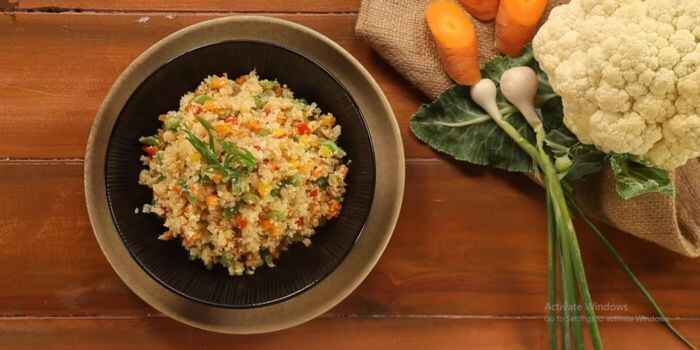
Season well with salt and pepper to enhance its flavors and textures. Cook until the cauliflower is tender, making sure to stir frequently. This seasoned cauliflower rice is not only a health-wise choice but also a tasty one, fitting perfectly into your daily vegetable servings without feeling heavy.
Cauliflower is a cruciferous vegetable, known for its nutritional benefits and versatility. By using cauliflower rice as a substitute for starchy rice, you can enjoy lighter meals while still savoring delicious dishes.
Why You Should Make Your Own Riced Cauliflower
Making riced cauliflower from scratch is a fantastic way to save money at the grocery store. A whole head of cauliflower is much cheaper than buying it already fresh or frozen. Plus, when it’s made fresh, it tastes better and can be used in any recipe that calls for rice.
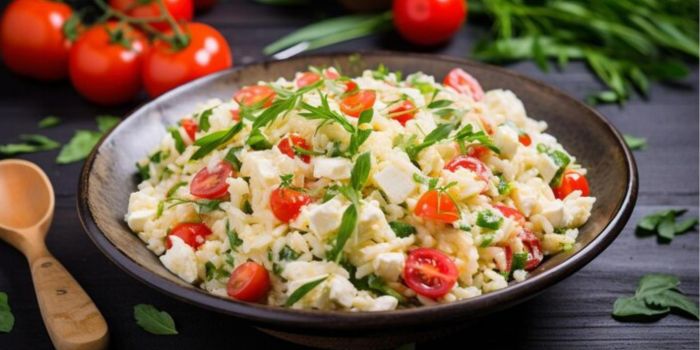
Incorporating plant-based foods into your diet is a great way to eat healthier. You can even sneak riced cauliflower into meatballs instead of using breadcrumbs – the kids will never know! It’s a perfect substitute for grains, offering fewer calories and fewer carbs. If you prefer to still eat rice, try a mix of half rice and half cauliflower to make your portions larger with added nutrients. Additionally, riced cauliflower is a naturally gluten-free side dish.

The Origin of Cauliflower Rice
Back in 1998, a chef named Ben Ford in California came up with the idea of using cauliflower as a grain-like base, which he called couscous. This concept was essentially the same thing as what we know today as cauliflower rice. The term “cauliflower rice” didn’t gain much traction until 2012 when it became an internet sensation.
This nutrient-rich rice substitute has been booming in popularity ever since. As someone who enjoys experimenting with easy home recipes for one, I find cauliflower rice to be a versatile and healthy alternative that’s perfect for my halal dietary preferences. It’s fascinating to see how a simple vegetable can transform into a staple in so many kitchens, offering a delightful, low-carb option that aligns with diverse culinary needs.
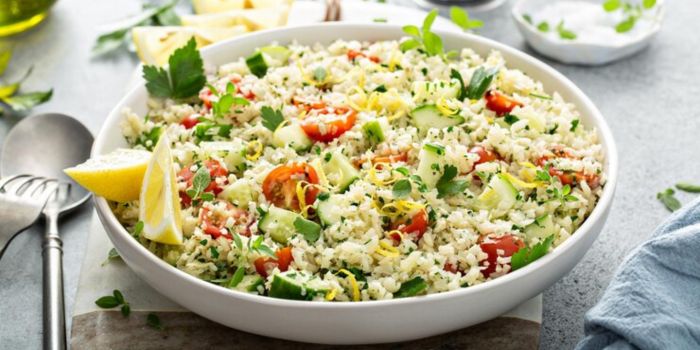
Ingredients:
- 1/4 medium cauliflower head, grated or finely chopped into rice-sized pieces
- 1 tablespoon olive oil
- 1/4 small onion, finely chopped
- 1 clove garlic, minced
- 1/4 cup diced carrots
- 1/4 cup peas
- Salt and pepper to taste
- Optional garnish: chopped parsley or cilantro
Method:
- Grate or finely chop the cauliflower to resemble rice grains.
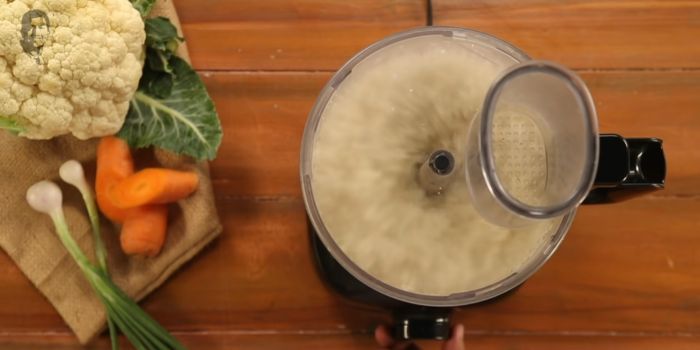
- Heat olive oil in a large skillet over medium heat.
- Add the chopped onion and sauté until translucent, about 2-3 minutes.

- Add the minced garlic and cook for another 1 minute until fragrant.
- Stir in the diced carrots and peas, and cook for 3-4 minutes until they start to soften.
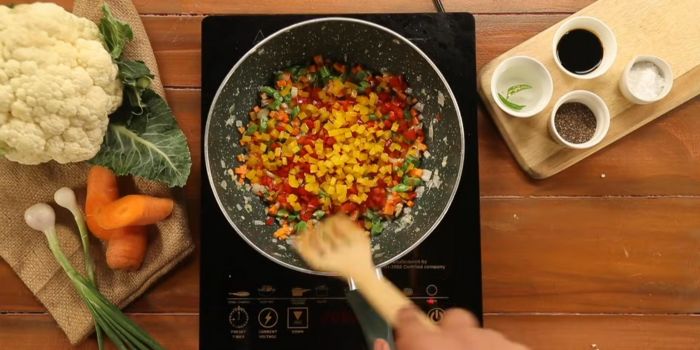
- Add the cauliflower rice to the skillet, mixing well with the vegetables.
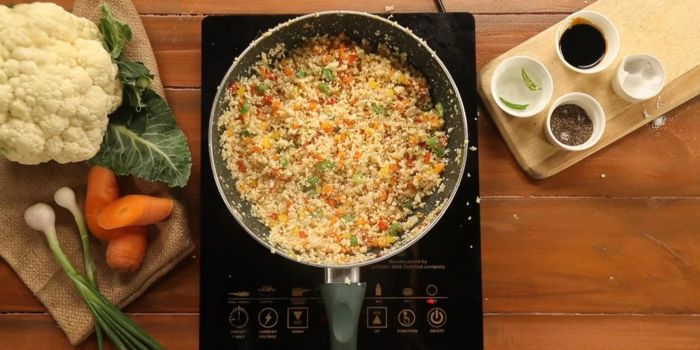
- Season with salt and pepper to taste.
- Cook, stirring frequently, for about 5-7 minutes until the cauliflower is tender but not mushy.
- Remove from heat and garnish with chopped parsley or cilantro if desired.
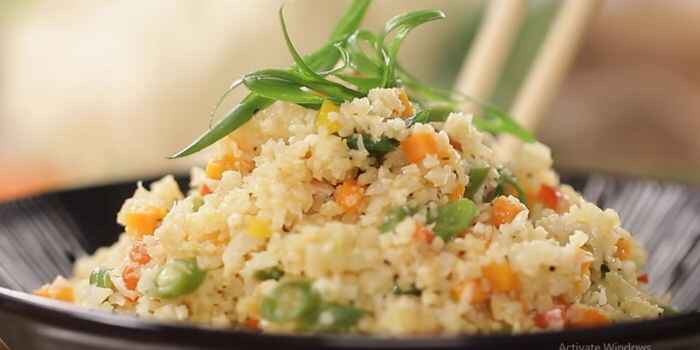
Additional Info About Cauliflower Rice
Here is some additional information that you may have to know about Cauliflower Rice Recipe.
Health Benefits:
- Low in Calories: Cauliflower rice is a low-calorie alternative to traditional rice, making it a good option for weight management.
- Rich in Fiber: Helps in digestion and promotes gut health.
- High in Vitamins: Provides a good amount of vitamins C and K, which are essential for immune function and bone health.
- Antioxidants: Contains antioxidants that help protect against cellular damage and inflammation.
Notes:
- You can add other vegetables or protein sources like chicken or tofu for variety.
- Adjust seasoning according to your taste preference.

Nutrition:
- Calories: 150
- Protein: 3g
- Carbohydrates: 15g
- Fat: 7g
- Fiber: 5g
Equipment:
- Grater or food processor
- Large skillet
- Knife
- Cutting board
- Spatula
Serving Suggestions
For a delightful and balanced meal, serve the Cauliflower Rice with Vegetables as a side dish or main course. This dish pairs wonderfully with grilled chicken, tofu, or a light fish filet. To enhance the flavors, consider drizzling a bit of soy sauce or adding a sprinkle of sesame seeds before serving. This dish is not only versatile but also packed with nutrients, making it a great addition to any meal.

If you’re looking to create a complete vegetarian meal, complement the cauliflower rice with a fresh garden salad and a bowl of creamy tomato soup. The combination of textures and flavors will provide a satisfying dining experience.
Additionally, you can top the cauliflower rice with a fried or poached egg for added protein, making it a perfect option for a hearty breakfast or a quick dinner. Garnishing with fresh herbs like parsley or cilantro adds a burst of color and a refreshing taste to the dish.
Storing Leftovers
When it comes to preserving the freshness of riced cauliflower, whether cooked or raw, storing methods are crucial. If you’re not planning to use your riced cauliflower immediately, you can refrigerate it for up to 4 days. This method works perfectly for those who love to prepare their meals in advance. For longer storage, freezing is a great option. Press out the moisture, place it in a sealed container or Stasher bags, and freeze for up to 1 month. This technique helps maintain the crumbles without them turning soggy when thawed.
Reheating
When it’s time to reheat, simplicity is key. You can Reheat your cauliflower rice in a microwave, oven, or on the stove. Each method ensures that the rice retains its texture and flavor, making it seem as if it was just cooked. If stored in the fridge, it can last between 3 to 5 days. The transfer from freezer to fridge a day before cooking is advised for a more even reheating process.

By ensuring your cauliflower rice is stored in food-safe, airtight containers, you not only extend its shelf life but also maintain its quality for various recipes. Whether you’re making a stir-fry or a side dish, proper storage and reheating methods can make all the difference.
No food processor?
If you don’t have a food processor, don’t worry! You can still make cauliflower rice using a grater. From my experience, a grease works better than the “S” blade of a food processor for achieving those perfect rice-size pieces. It’s a bit messier, though, as you’ll find little bits of cauliflower scattered on the counter and probably on the floor. Despite the mess, the result is worth it, and you can quickly clean up after enjoying your healthy, homemade cauliflower rice.
DON’T HAVE A GRATING DISC ATTACHMENT?
If you want to make cauliflower rice at home but lack a grating disc, you can use the default S curve blade of your food processor. Though it may result in uneven pieces, with some patience, you can still get a decent texture.

Cut the cauliflower into small florets and use the S blade to grate. While a grating disc is better, the S curve blade will produce a mix of sizes. Pulse in short bursts to avoid over-processing. With practice, you’ll learn the optimal pulsing time. You’ll end up with fresh cauliflower rice, a healthy and versatile alternative to traditional rice.
Recipe Variations
When making cauliflower rice, I love to add a burst of flavor with fresh lemon juice and herbs at the end. A squeeze of lime juice combined with minced garlic also brings out a delightful zest. Depending on your palate, try using your favorite spices in place of just salt and pepper. For an Asian flair, a splash of soy sauce can make all the difference. Don’t be afraid to add these elements to enhance the dish. The blend of these ingredients transforms simple cauliflower rice into a vibrant, tasty side dish that’s perfect for any meal.

Is Cauliflower Rice Actually Healthy?
Switching to cauliflower rice boosts antioxidants, reduces calories and carbs, and provides nutrient-rich food. It’s versatile, quick to cook, and great for weight loss, blood sugar control, and cleaner eating.
Does Cauliflower Rice Taste Like Rice?
Switching to cauliflower rice instead of white rice boosts antioxidants, reduces calories and carbs, and offers more nutrients. It’s versatile, quick to prepare, and makes meals lighter and more energizing, supporting weight loss, blood sugar management, and cleaner eating.
Is Cauliflower Rice Good for You?
I was amazed at how nutritious cauliflower rice is, packed with vitamins C and K. It’s fat-free, cholesterol-free, low sodium, with just 150 calories, 15 grams of carbohydrates, and 5 grams of dietary fiber per cup, making it a healthy choice.
Can I Eat Cauliflower Every Day?
Cauliflower rice is nutritious and low in calories, making it a healthy choice. However, consult a doctor if you have a thyroid disorder, as cauliflower can interfere with iodine absorption.
Revolutionize Dinner: Easy Cauliflower Rice Recipe!
Cauliflower rice is a simple and low-carb alternative to traditional rice, perfect for anyone looking to add more vegetables to their diet.

Ingredients
Method
-
Grate or finely chop the cauliflower to resemble rice grains.
-
Heat olive oil in a large skillet over medium heat.
-
Add the chopped onion and sauté until translucent, about 2-3 minutes.
-
Add the minced garlic and cook for another 1 minute until fragrant.
-
Stir in the diced carrots and peas, and cook for 3-4 minutes until they start to soften.
-
Add the cauliflower rice to the skillet, mixing well with the vegetables.
-
Season with salt and pepper to taste.
-
Cook, stirring frequently, for about 5-7 minutes until the cauliflower is tender but not mushy.
-
Remove from heat and garnish with chopped parsley or cilantro if desired.
Nutrition Facts
Servings 2
- Amount Per Serving
- Calories 150kcal
- % Daily Value *
- Total Carbohydrate 15g5%
- Dietary Fiber 5g20%
- Protein 3g6%
* Percent Daily Values are based on a 2,000 calorie diet. Your daily value may be higher or lower depending on your calorie needs.
Note
- You can add other vegetables or protein sources like chicken or tofu for variety.
- Adjust seasoning according to your taste preference.


